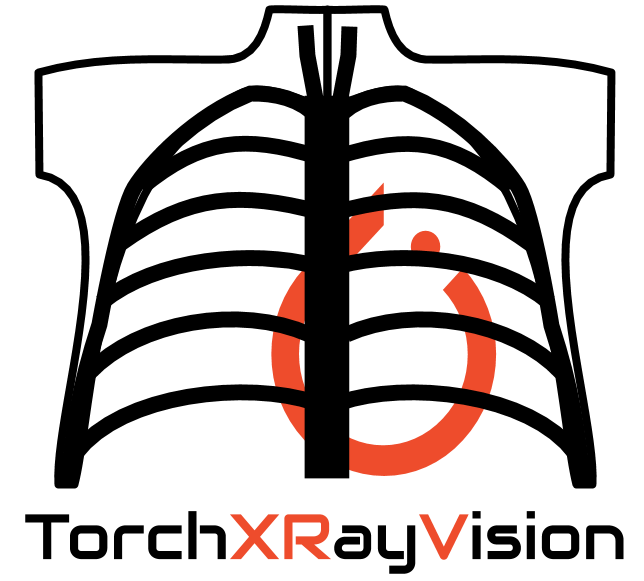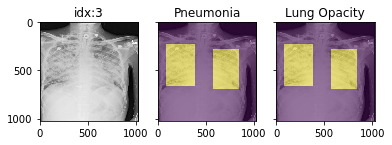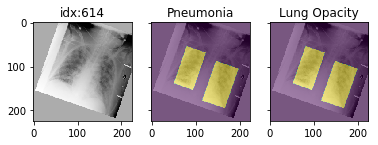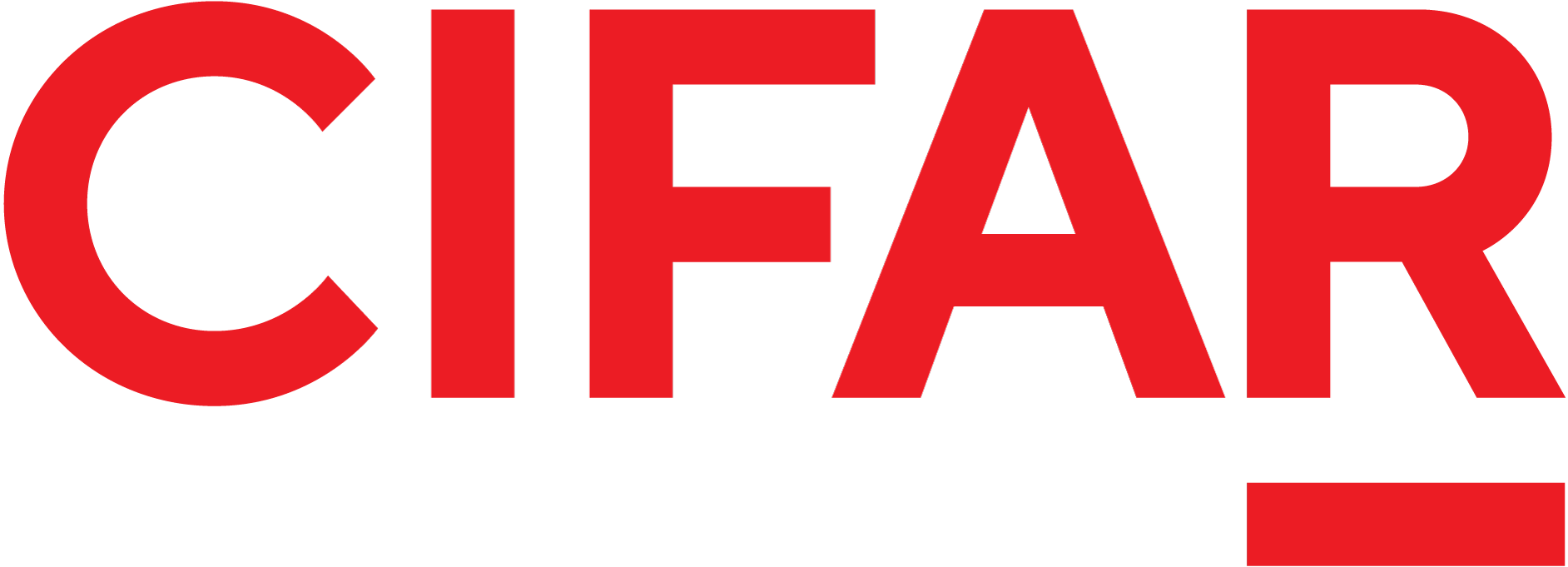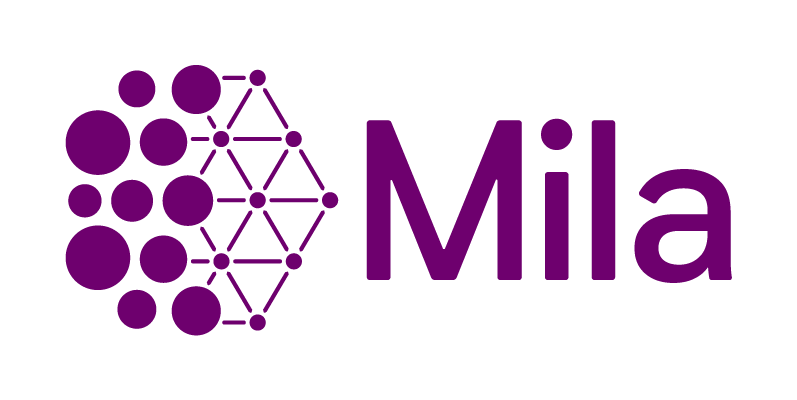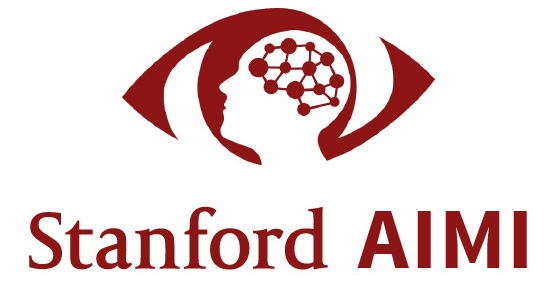🚨 Paper now online! https://arxiv.org/abs/2111.00595
A library for chest X-ray datasets and models. Including pre-trained models.
(🎬 promo video about the project)
TorchXRayVision is an open source software library for working with chest X-ray datasets and deep learning models. It provides a common interface and common pre-processing chain for a wide set of publicly available chest X-ray datasets. In addition, a number of classification and representation learning models with different architectures, trained on different data combinations, are available through the library to serve as baselines or feature extractors.
- In the case of researchers addressing clinical questions it is a waste of time for them to train models from scratch. To address this, TorchXRayVision provides pre-trained models which are trained on large cohorts of data and enables 1) rapid analysis of large datasets 2) feature reuse for few-shot learning.
- In the case of researchers developing algorithms it is important to robustly evaluate models using multiple external datasets. Metadata associated with each dataset can vary greatly which makes it difficult to apply methods to multiple datasets. TorchXRayVision provides access to many datasets in a uniform way so that they can be swapped out with a single line of code. These datasets can also be merged and filtered to construct specific distributional shifts for studying generalization.
This code is still under development
Twitter: @torchxrayvision
pip install torchxrayvision
import torchxrayvision as xrv
These are default pathologies:
xrv.datasets.default_pathologies
['Atelectasis',
'Consolidation',
'Infiltration',
'Pneumothorax',
'Edema',
'Emphysema',
'Fibrosis',
'Effusion',
'Pneumonia',
'Pleural_Thickening',
'Cardiomegaly',
'Nodule',
'Mass',
'Hernia',
'Lung Lesion',
'Fracture',
'Lung Opacity',
'Enlarged Cardiomediastinum']A sample script to process images usings pretrained models is process_image.py
$python3 process_image.py ../tests/00000001_000.png
{'preds': {'Atelectasis': 0.50500506,
'Cardiomegaly': 0.6600903,
'Consolidation': 0.30575264,
'Edema': 0.274184,
'Effusion': 0.4026162,
'Emphysema': 0.5036339,
'Enlarged Cardiomediastinum': 0.40989172,
'Fibrosis': 0.53293407,
'Fracture': 0.32376793,
'Hernia': 0.011924741,
'Infiltration': 0.5154413,
'Lung Lesion': 0.22231922,
'Lung Opacity': 0.2772148,
'Mass': 0.32237658,
'Nodule': 0.5091847,
'Pleural_Thickening': 0.5102617,
'Pneumonia': 0.30947986,
'Pneumothorax': 0.24847917}}
Models (demo notebook)
Specify weights for pretrained models (currently all DenseNet121)
Note: Each pretrained model has 18 outputs. The all model has every output trained. However, for the other weights some targets are not trained and will predict randomly becuase they do not exist in the training dataset. The only valid outputs are listed in the field {dataset}.pathologies on the dataset that corresponds to the weights.
## 224x224 models
model = xrv.models.DenseNet(weights="densenet121-res224-all")
model = xrv.models.DenseNet(weights="densenet121-res224-rsna") # RSNA Pneumonia Challenge
model = xrv.models.DenseNet(weights="densenet121-res224-nih") # NIH chest X-ray8
model = xrv.models.DenseNet(weights="densenet121-res224-pc") # PadChest (University of Alicante)
model = xrv.models.DenseNet(weights="densenet121-res224-chex") # CheXpert (Stanford)
model = xrv.models.DenseNet(weights="densenet121-res224-mimic_nb") # MIMIC-CXR (MIT)
model = xrv.models.DenseNet(weights="densenet121-res224-mimic_ch") # MIMIC-CXR (MIT)
# 512x512 models
model = xrv.models.ResNet(weights="resnet50-res512-all")
# DenseNet121 from JF Healthcare for the CheXpert competition
model = xrv.baseline_models.jfhealthcare.DenseNet()
# Official Stanford CheXpert model
model = xrv.baseline_models.chexpert.DenseNet()Benchmarks of the modes are here: BENCHMARKS.md
The performance of some of the models can be seen in this paper arxiv.org/abs/2002.02497.
You can also load a pre-trained autoencoder that is trained on the PadChest, NIH, CheXpert, and MIMIC datasets.
ae = xrv.autoencoders.ResNetAE(weights="101-elastic")
z = ae.encode(image)
image2 = ae.decode(z)Images can be processed as follows from disk to be input to the model:
img = skimage.io.imread(img_path)
img = xrv.datasets.normalize(img, 255)
# Check that images are 2D arrays
if len(img.shape) > 2:
img = img[:, :, 0]
if len(img.shape) < 2:
print("error, dimension lower than 2 for image")
# Add color channel
img = img[None, :, :]
transform = torchvision.transforms.Compose([xrv.datasets.XRayCenterCrop(),
xrv.datasets.XRayResizer(224)])
img = transform(img)
Datasets (demo notebook)
Only stats for PA/AP views are shown. Datasets may include more.
transform = torchvision.transforms.Compose([xrv.datasets.XRayCenterCrop(),
xrv.datasets.XRayResizer(224)])
d_kaggle = xrv.datasets.RSNA_Pneumonia_Dataset(imgpath="path to stage_2_train_images_jpg",
transform=transform)
d_chex = xrv.datasets.CheX_Dataset(imgpath="path to CheXpert-v1.0-small",
csvpath="path to CheXpert-v1.0-small/train.csv",
transform=transform)
d_nih = xrv.datasets.NIH_Dataset(imgpath="path to NIH images")
d_nih2 = xrv.datasets.NIH_Google_Dataset(imgpath="path to NIH images")
d_pc = xrv.datasets.PC_Dataset(imgpath="path to image folder")
d_covid19 = xrv.datasets.COVID19_Dataset() # specify imgpath and csvpath for the dataset
d_siim = xrv.datasets.SIIM_Pneumothorax_Dataset(imgpath="dicom-images-train/",
csvpath="train-rle.csv")
d_vin = xrv.datasets.VinBrain_Dataset(imgpath=".../train",
csvpath=".../train.csv")National Library of Medicine Tuberculosis Datasets paper
d_nlmtb = xrv.datasets.NLMTB_Dataset(imgpath="path to MontgomerySet or ChinaSet_AllFiles")
Using MontgomerySet data:
NLMTB_Dataset num_samples=138 views=['PA']
{'Tuberculosis': {0: 80, 1: 58}}
or using ChinaSet_AllFiles data:
NLMTB_Dataset num_samples=662 views=['PA', 'AP']
{'Tuberculosis': {0: 326, 1: 336}}Each dataset contains a number of fields. These fields are maintained when xrv.datasets.Subset_Dataset and xrv.datasets.Merge_Dataset are used.
Each dataset has a .pathologies field which is a list of the pathologies contained in this dataset that will be contained in the .labels field ].
Each dataset has a .labels field which contains a 1,0, or NaN for each label defined in .pathologies.
Each dataset has a .csv field which corresponds to pandas DataFrame of the metadata csv file that comes with the data. Each row aligns with the elements of the dataset so indexing using .iloc will work.
If possible, each dataset's .csv will have some common fields of the csv. These will be aligned when The list is as follows:
csv.patientid A unique id that will uniqely identify samples in this dataset
csv.offset_day_int An integer time offset for the image in the unit of days. This is expected to be for relative times and has no absolute meaning although for some datasets it is the epoch time.
relabel_dataset will align labels to have the same order as the pathologies argument.
xrv.datasets.relabel_dataset(xrv.datasets.default_pathologies , d_nih) # has side effectsspecify a subset of views (demo notebook)
d_kaggle = xrv.datasets.RSNA_Pneumonia_Dataset(imgpath="...",
views=["PA","AP","AP Supine"])specify only 1 image per patient
d_kaggle = xrv.datasets.RSNA_Pneumonia_Dataset(imgpath="...",
unique_patients=True)obtain summary statistics per dataset
d_chex = xrv.datasets.CheX_Dataset(imgpath="CheXpert-v1.0-small",
csvpath="CheXpert-v1.0-small/train.csv",
views=["PA","AP"], unique_patients=False)
CheX_Dataset num_samples=191010 views=['PA', 'AP']
{'Atelectasis': {0.0: 17621, 1.0: 29718},
'Cardiomegaly': {0.0: 22645, 1.0: 23384},
'Consolidation': {0.0: 30463, 1.0: 12982},
'Edema': {0.0: 29449, 1.0: 49674},
'Effusion': {0.0: 34376, 1.0: 76894},
'Enlarged Cardiomediastinum': {0.0: 26527, 1.0: 9186},
'Fracture': {0.0: 18111, 1.0: 7434},
'Lung Lesion': {0.0: 17523, 1.0: 7040},
'Lung Opacity': {0.0: 20165, 1.0: 94207},
'Pleural Other': {0.0: 17166, 1.0: 2503},
'Pneumonia': {0.0: 18105, 1.0: 4674},
'Pneumothorax': {0.0: 54165, 1.0: 17693},
'Support Devices': {0.0: 21757, 1.0: 99747}}Pathology masks (demo notebook)
Masks are available in the following datasets:
xrv.datasets.RSNA_Pneumonia_Dataset() # for Lung Opacity
xrv.datasets.SIIM_Pneumothorax_Dataset() # for Pneumothorax
xrv.datasets.NIH_Dataset() # for Cardiomegaly, Mass, Effusion, ...Example usage:
d_rsna = xrv.datasets.RSNA_Pneumonia_Dataset(imgpath="stage_2_train_images_jpg",
views=["PA","AP"],
pathology_masks=True)
# The has_masks column will let you know if any masks exist for that sample
d_rsna.csv.has_masks.value_counts()
False 20672
True 6012
# Each sample will have a pathology_masks dictionary where the index
# of each pathology will correspond to a mask of that pathology (if it exists).
# There may be more than one mask per sample. But only one per pathology.
sample["pathology_masks"][d_rsna.pathologies.index("Lung Opacity")]it also works with data_augmentation if you pass in data_aug=data_transforms to the dataloader. The random seed is matched to align calls for the image and the mask.
Distribution shift tools (demo notebook)
The class xrv.datasets.CovariateDataset takes two datasets and two
arrays representing the labels. The samples will be returned with the
desired ratio of images from each site. The goal here is to simulate
a covariate shift to make a model focus on an incorrect feature. Then
the shift can be reversed in the validation data causing a catastrophic
failure in generalization performance.
ratio=0.0 means images from d1 will have a positive label ratio=0.5 means images from d1 will have half of the positive labels ratio=1.0 means images from d1 will have no positive label
With any ratio the number of samples returned will be the same.
d = xrv.datasets.CovariateDataset(d1 = # dataset1 with a specific condition
d1_target = #target label to predict,
d2 = # dataset2 with a specific condition
d2_target = #target label to predict,
mode="train", # train, valid, and test
ratio=0.9)Primary TorchXRayVision paper: https://arxiv.org/abs/2111.00595
Joseph Paul Cohen, Joseph D. Viviano, Paul Bertin, Paul Morrison, Parsa Torabian, Matteo Guarrera, Matthew P Lungren, Akshay Chaudhari, Rupert Brooks, Mohammad Hashir, Hadrien Bertrand
TorchXRayVision: A library of chest X-ray datasets and models.
https://github.com/mlmed/torchxrayvision, 2020
@article{Cohen2020xrv,
author = {Cohen, Joseph Paul and Viviano, Joseph D. and Bertin, Paul and Morrison, Paul and Torabian, Parsa and Guarrera, Matteo and Lungren, Matthew P and Chaudhari, Akshay and Brooks, Rupert and Hashir, Mohammad and Bertrand, Hadrien},
journal = {https://github.com/mlmed/torchxrayvision},
title = {{TorchXRayVision: A library of chest X-ray datasets and models}},
url = {https://github.com/mlmed/torchxrayvision},
year = {2020}
arxivId = {2111.00595},
}
and this paper which initiated development of the library: https://arxiv.org/abs/2002.02497
Joseph Paul Cohen and Mohammad Hashir and Rupert Brooks and Hadrien Bertrand
On the limits of cross-domain generalization in automated X-ray prediction.
Medical Imaging with Deep Learning 2020 (Online: https://arxiv.org/abs/2002.02497)
@inproceedings{cohen2020limits,
title={On the limits of cross-domain generalization in automated X-ray prediction},
author={Cohen, Joseph Paul and Hashir, Mohammad and Brooks, Rupert and Bertrand, Hadrien},
booktitle={Medical Imaging with Deep Learning},
year={2020},
url={https://arxiv.org/abs/2002.02497}
}
CIFAR (Canadian Institute for Advanced Research)
Mila, Quebec AI Institute, University of Montreal
Stanford University's Center for Artificial Intelligence in Medicine & Imaging
Carestream Health
